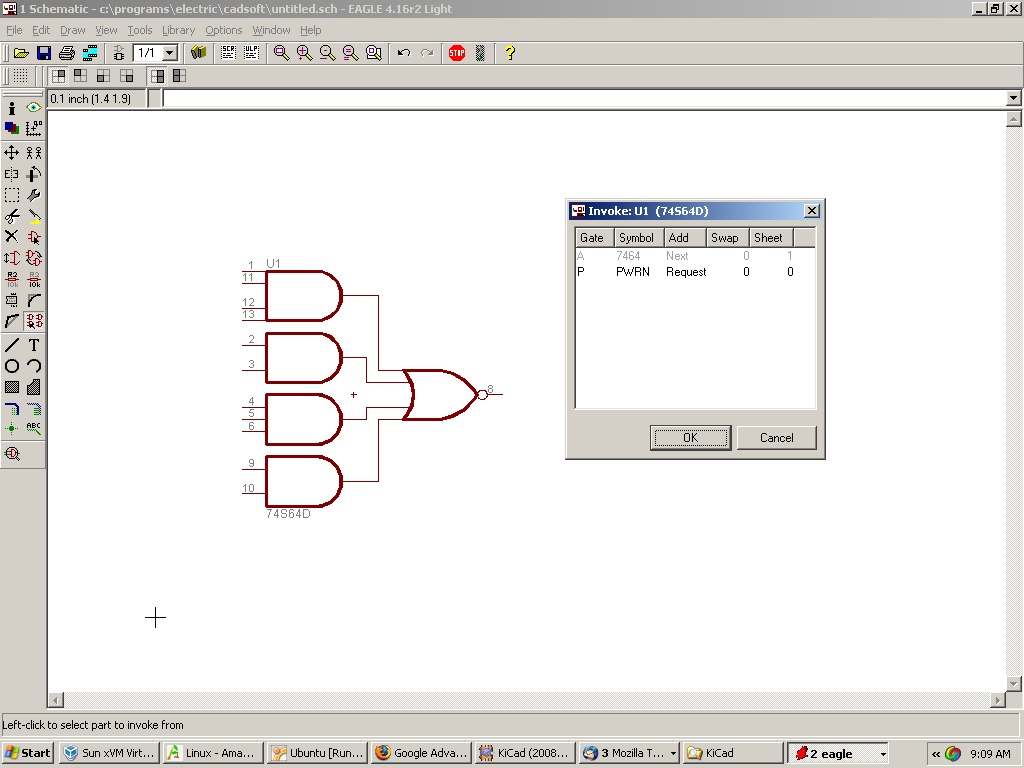[Author Prev][Author Next][Thread Prev][Thread Next][Author Index][Thread Index]
Re: gEDA-user: Slotting and visible power connections
Bernd Jendrissek wrote:
On Wed, Nov 5, 2008 at 8:06 PM, Joerg <joergsch@xxxxxxxxxxxxxxxxxxxxx> wrote:
When you place, say, a LM324 as the seventh chip it will plop down U7A.
What do you mean "place ... as the seventh chip"? Do you mean when
you place your 25th opamp symbol that happens to be realized as 1/4 of
a LM324?
Just an example. If it's the first it would place U1A. But when you
place the next instantation (or slot in gschem-speak) it'll be U1B, and
so forth.
How does Eagle deal with, say, a "7464: 4-2-3-2-Input AND-OR-INVERT
Gate" (randomly picking from a 7400-series list)?
It places that as one complete device. Because that's what it is, it
combines all four intermediate outputs on the chip, you cannot separate
that.
Only U7A, U8A and so
on have power pins.
Why? What's so special about the "A" slots?
It doesn't look professional if U7B, U7C and U7D repeat the power
connections. In schematics the power is either not shown at all
(implicit) or only on the first instantation (slot). In 20+ years I have
never seen it any other way on any schematic, and as a consultant I come
across tons of schematics.
If you pick a device with implicit pins and suddenly
find out "Oh, I better filter that chip over there separately" you click
an invoke tab and the hidden power pins show up on the -A slot. But only
for the device you click after invoke, not all of them.
Hmm, how do you prevent yourself from doing incompatible things with
the various slots' power supplies? Say, for example, that in one part
of your schematic you have an opamp where you use the power pins as
outputs, but in another part of the schematic far far away, you're
filtering the power supply?
That is why us analog guys rarely work with implicit power pins. In
Eagle you simply click the invoke command and then the power pins for
the selected device pop up. In other CAD systems such as KiCad you need
to use a different library version of the same part, one that has power
pins on the first slot (but not on all the others). KiCad libraries also
seems to show explicit power pins on all slots because the authors of
those libraries chose to. So I'd have to rework all the parts I may
need. But it's a rather simple pin edit to do that. AFAIU that cannot be
done via a library edit in gschem. IIUC you can only have power pins on
all slots or not at all (and if you want to, a separate power part).
Are the hidden power pins always there but not visible? In another of
your replies it seems like Eagle is adding a *separate* power symbol
on top of the opamp symbol, judging by the "U7P" refdes that gets in
your way.
I guess I don't "get" what this "invoke" tab is. Can you send me a
screenshot (privately) - maybe that will help me understand?
I am using this NG through gmane and they don't show email addresses for
privacy reasons. If the attachment doesn't make it into this post send
me a quick email (address is on my web site below) and I'll email you
the screen shot.
When you renumber it leaves those instantations intact, if you don't let
it then it will not swap, for example, U7C with U8A. This is important
for situation where some not-so-orthodox compensation scheme relies on
the fact that circuits are on the same die.
Heh, I wonder how this would affect gate-swapping back-annotation.
The PCB layout tool would have to be smart enough to know that SOME
identical-looking gates/opamps can be swapped, but not ALL.
They do. And it depends what you tell the layouter. For example
sometimes (if I need same die temp tracking) I allow him to swap within
a device. Sometimes I tell him to feel free to swap any instantations,
even across devices.
elsewhere you wrote:
That could quickly lead to an island solution where there is no way back
to where everybody else is.
It sounds worse than it is; yes it takes work to merge the forks again
after a period of divergence, but it isn't like speciation in nature
where there's no way back. I've managed to keep my fork(s) in sync
with the mainline code so far. (This isn't a symmetric relation,
though.)
Trouble is, I am not at all a software professional. I design
electronics including rather tricky stuff but I can't deal with C-Code,
Perl, and all that. To some extent I could but certainly not bringing a
fork back home.
--
Regards, Joerg
http://www.analogconsultants.com/
"gmail" domain blocked because of excessive spam.
Use another domain or send PM.

_______________________________________________
geda-user mailing list
geda-user@xxxxxxxxxxxxxx
http://www.seul.org/cgi-bin/mailman/listinfo/geda-user
